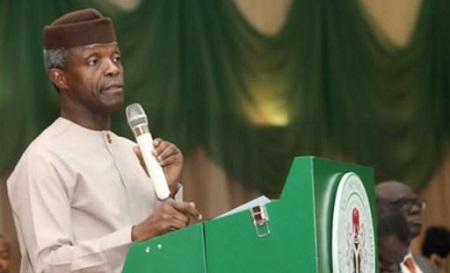
Nigeria’s Vice President Yemi Osinbajo has, once again, taken the helm of Africa’s most popolous nation while President Muhammadu Buhari is in the UK for follow-up medical examinations.
Buhari, 74, spent nearly two months on medical leave in London earlier this year, sparking speculations on his health and the future of one of Africa’s largest economies. He left again on 7 May.
Before leaving Nigeria on both occasions, Buhari appointed his deputy as acting president. Osinbajo has won praise for the leadership skills he demonstrated during Buhari’s absence, fuelling speculations he could replace Buhari if the latter became incapacitated.
Here are 5 things that Osinbajo has done while acting president:
1. Pledged help for victims of Boko Haram insurgency
After meeting with 82 girls released by Boko Haram insurgents in May, Osinbajo vowed the federal government would prioritise investments to foster the welfare of people affected by the insurgency. in the country’s northeast.
Boko Haram fights against Western influence in Nigeria and aims to impose its version of Sharia law throughout occupied territories. The UN says at least 20,000 people have died in Nigeria and neighbouring states since the Boko Haram insurgency became violent in 2009. The conflict has also displaced at least 2.1 million people.
“When you speak of the budget of Presidential Initiative on the North-East (PINE) and Borno state and the other initiatives in the Northeast, I think we have to take a second look on all of these issues,” Osinbajo said. He added the current allocation for humanitarian services in the region was inadequate.
2. Fostered peace talks with Niger Delta militants
Osinbajo was appointed as head of a delegation tasked with resolving the ongoing crisis in the Niger Delta. The oil-rich region is seeing renewed violence at the hands of militant groups that bomb oil and gas facilities, calling for an end to perceived disenfranchisement. Groups also demand greater shares of oil revenues.
Earlier this year, Osinbajo met with leader of the restive Niger Delta region to discuss solutions to violence in the area.
On 9 May, he chaired a meeting of an Inter-Ministerial Comittee on Niger Delta.
3. Visited the Emir of Katsina
Osinbajo visited Abdulmumini Kabir Usman , the Emir of Katsina, a state in northern Nigeria. The pair discussed a plan to extend a railway line connecting Kaduna and Kano – two states in nortwestern Nigeria – to Katsina to boost socio-economic development in the area.
While in Katsina, the acting president also attended the launch ceremony of a Pilot Edition of Micro, Small and Medium Enterprises Clinic for viable enterprises in the state, the News Agency of Nigeria (NAN) reported on 11 May.
4. Addressed protesters’ grievances
Osinbajo addressed grievances of the protesters who were calling for economic reforms, and launched a 60-day action plan to improve the business climate.
Protesters stormed the capital Abuja and the city of Lagos in February, calling for better governance amid the ongoing economic crisis. Among other things, people protested against unemployment and issues including rising costs of foods and medicines, access to education and lack of services including electricity.
5. Inaugurated the Nigeria Sovereign Investment Authority (NSIA)
In May, Osinbajo inaugurated the second of board of NSIA. The inauguration took place after Buhari had approved the nominees earlier this year.
NSIA is a government-owned investment agency. Established in 2011, it manages state funds destined for investments.
****
Via International Business Times






